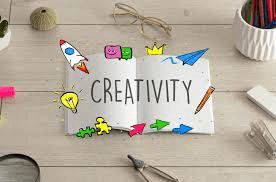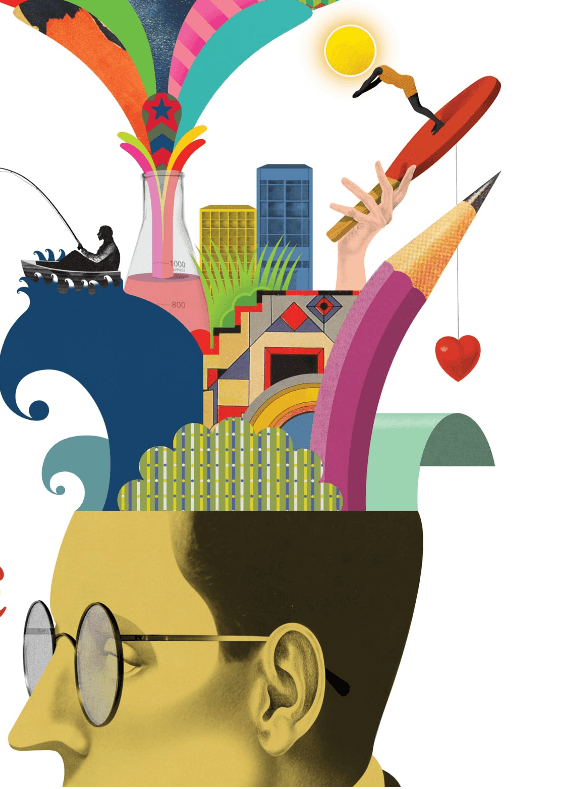Creativity DefinitionIntroduction
The creation of anything original and noteworthy is a creative phenomenon. Examples of tangible creations include an innovation, a printed literary work, or a physical object. Examples of intangible creations include ideas, scientific theories, music, jokes, and physical objects. The three main academic disciplines interested in creativity are psychology, business studies, and cognitive science. It exists not just in the social sciences (such as sociology, linguistics, and economics) but also the natural sciences (such as physics, chemistry, and biology), the physical sciences (such as chemistry and biology), the arts, and theology. These research areas examine the relationships between creativity and general intelligence, personality type, mental and neurological processes, mental health, and artificial intelligence, as well as the potential for fostering creativity through instruction, leadership, and organizational practices. Definition
According to Michael Mumford's analysis of the scientific literature on creativity, "over the last decade, however, we seem to have reached a general agreement that creativity involves the production of a novel, useful products" (Mumford, 2003, p. 110), or in Robert Sternberg's words, the production of "something original and worthwhile." Beyond these overarching parallels, authors' precise definitions have differed considerably: According to Peter Meusburger, there are more than a hundred definitions of creativity in the literature, most of which elaborate on the context (field, organization, environment, etc.) that determines the originality and appropriateness of the produced object well as the creative processes that produced it. Dr. E. Paul Torrance defined creativity as "a process of becoming sensitive to problems, deficiencies, gaps in knowledge, missing elements, disharmonies, and so forth; identifying the difficulty; searching for solutions, making educated guesses, or formulating hypotheses about the deficiencies: testing and retesting these hypotheses and possibly modifying and retesting them; and finalizing." When the focus is on execution, it is typical to make a distinction between creativity in general and Innovation in particular. In contrast, to how the OECD and Eurostat define creativity, Teresa Amabile and Pratt (2016) define Innovation as the application of creative ideas. They explain, "Innovation is more than a new concept or creation, and Innovation must be applied directly or by making it available to other parties, corporations, individuals, or organizations. Emotional creativity is another term for cognitive abilities and personality traits connected to uniqueness and suitability in emotional experience. AspectsWhy some people are more creative than others is one of the many topics theories of creativity have looked into. The "four Ps"?process, product, person, and place/press?are typically acknowledged as the essential elements. Mel Rhodes initially introduced this idea. The process is the main focus of cognitive approaches that aim to define thought processes and methods for creative thinking. Theories of the creative process include those like Guilford's, which emphasize divergent rather than convergent thought, and those like Wallas', which describe the staging of the creative process. Evaluations of creative work are frequently the focus, whether for psychometrics or to comprehend why some items are viewed as creative. An analysis of the product yields the standard definition of creativity as the invention of something novel and beneficial. Focusing on the characteristics of the creative person entails considering more general intellectual practices like openness, degrees of creativity, autonomy, knowledge, curious behavior, and so forth. A place-based strategy, often referred to as press, considers factors that encourage Innovation, including levels of autonomy, resource accessibility, and the characteristics of gatekeepers. Creative lifestyles are characterized by adaptability and nonconformist attitudes and activities. Characteristics of Creative People
Numerous personality characteristics are related to creative output. Autonomy is listed among these: People who think and act independently and unconventionally are likely to be creative. It's equally important to be an expert in a certain field of knowledge or one that calls for a high level of ability. For instance, by making the computer industry appealing to individuals and businesses while building the Apple II, creators Steve Jobs and Steve Wozniak changed the sector. By creating simple yet fashionable clothing, French fashion designer Coco Chanel revolutionized the way women dressed for all time. However, not all human abilities are valued by creative individuals similarly. (Leonardo da Vinci is an exception, showcasing their creative polymath skills through his contributions to engineering, mechanics, and the fine arts.) Some creative people are interested in conflict, imbalance, and confusion; this could be because they find asymmetry and instability difficult. Another characteristic that may be present in creative persons is a high degree of confidence. Some individuals possess a surprisingly deep, expansive, and flexible awareness of themselves. Some are shown to be intellectual leaders who are extremely problem-sensitive. When creative people have divergent ideas, it may be because they are fighting acculturation, which they see as demanding the loss of their fundamental identity. Since creative people work alone and aren't scared to express ideas or produce extreme work, independence is crucial to the creative process. However, it should be highlighted that creativity does not necessarily require a nonconformist way of life. Creative people lead rather normal lives, expressing their freedom primarily via their wacky ideas and creative output. Another trait that many creative people possess is introversion. The implication is that creative people tend to be self-aware and inwardly focused, which does not imply a lack of social skills. Their intuition influences their views and acts more strongly than their interactions. A third crucial trait combines problem-solving and curiosity. Creative people frequently have a taste for novelty and the capacity to ask original questions. A creative individual sees a need?possibly a problem or an opportunity?that no one else does. This phase is called "buying low" since it typically entails rejecting a conventional solution and embracing an unusual or unpopular idea. A creative person will then try to "sell" the concept to others after finding a better solution. The inventions of inventors like Dean Kamen, whose numerous achievements include medical equipment, water purification systems, and the IBOT, a motorized wheelchair, might serve as examples of this method; Text scanners and speech recognition software were developed by Raymond Kurzweil, Margaret Knight, and others, as well as consumer and corporate products. Creative people tend to be highly intelligent, but even though they can approach problems as logically as anybody else, their intellect does not overrule their intuition or other apparent irrational instincts. A high level of general intelligence only sometimes encourages creativity, according to most studies on the relationship between intelligence and creativity. The "threshold" notion of intelligence and creativity contends that intelligence and creativity diverge at a certain point and that a highly intelligent. The amount of information a person can absorb and retain may be constrained by intelligence, but creative thinking provides the adaptability necessary for the original invention of ideas. Divergent and convergent thinking are occasionally distinguished (exemplified by a wealth of ideas and originality). Analytical reasoning is the component of convergence thinking that intelligence testing evaluates. Both appear crucial for creative performance. However, the importance of each varies depending on the task or profession (for example, a mathematician might show more convergent than divergent thinking, whereas an artist might show the opposite). Psychological studies in motivation and learning have shown the effectiveness of surprise as a motivational factor. This results from the tension between interruptions that present opportunities for unique experiences and daily monotony. The conflict between reason and intuition, the conscious and unconscious, mental health and mental disorder, the ordinary and the extraordinary, complexity and simplicity, and other dualities have been documented in the psychological investigations of highly creative persons. E. Paul Torrance, an American educational psychologist, identified other traits of creative persons. Fluency, or the capability to generate many ideas quickly; flexibility, the ability to employ ideas and tools in unique ways; and creativity, the ability to generate new concepts and ideas, are a few examples. The Torrance Test of Creative Thinking (TTCT), created in 1966 by Torrance and his partners, considers all these abilities. The TTCT is one of the most popular tests of originality. Follow-up examinations of Torrance's participants at 7, 12, and 22 years have shown that the TTCT is among the more trustworthy of all creativity tests. These investigations strengthened the case for Torrance's approach. Investigation into the Creative ProcessIn the latter half of the 20th century, the American psychologist Mihaly Csikszentmihalyi, who was born in Hungary, studied over 90 individuals who shared the following characteristics:
Csikszentmihalyi's findings, published in Creativity: The Psychology of Innovation, refuted past hypotheses claiming creative people arose from conflicted households. These individuals had mostly had typical childhoods and had grown up in households that instilled a solid foundation of values in them, according to Flow and the Psychology of Discovery and Invention (1996). The fact that some of them had gone through parental loss, particularly the loss of a father, set them apart from most individuals. The majority of these individuals were driven and influenced by supportive adults. Furthermore, Csikszentmihalyi's research identified creative individuals with negative perceptions of their elementary and secondary education. They acquired better critical thinking skills somewhere else, either in school or through extra training that put them in touch with mentors and powerful teachers. Albert Einstein's two uncles fostered his early interest in mathematics and science despite obtaining below-average grades in his early school years. Csikszentmihalyi's research indicates that many creative people made wrong turns on their route to success. But what was most impressive was how they seized opportunities and overcame challenges. Generally speaking, they shaped events to fit their purposes and made little attempt to hide the fact that factors outside of their control constrained them. These individuals appeared motivated by the thrill and satisfaction of accomplishing their goals to overcome difficulties. According to Csikszentmihalyi's research, the ability for "flow," which he defined as individuals' complete and timeless immersion in the task at hand, separates creative people from other sorts of people. People in a flow believe that their skills are barely sufficient to address the problems, so they become fully engaged in the creative process. Notably, Csikszentmihalyi hypothesized that some creative persons might desire to flow as escapism, as being completely involved in the creative process provides them a sense of comfort or control. Like "intrinsic motivation," which is a drive that develops from a strong sense of autonomous interest in the job at hand, flow is a state of mind that can be compared to. It is complemented by extrinsic motivation, which results from the desire to accomplish objectives another person or organization establishes. ConclusionThe capacity to create something novel through creative thinking, be it a novel approach to a problem, a novel tool or technique, or a novel work of art. The phrase generally denotes intellectual depth and creativity.
Next TopicDefine integral Formula
|
 For Videos Join Our Youtube Channel: Join Now
For Videos Join Our Youtube Channel: Join Now
Feedback
- Send your Feedback to [email protected]
Help Others, Please Share










